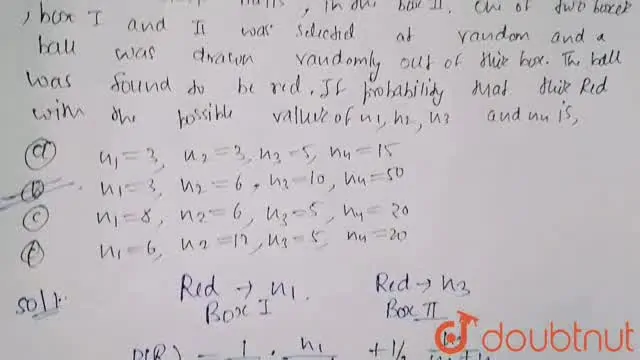Let be the number of red and black balls, respectively, in box I. Let be the numbers of red and black balls, respectively, in the box II.
One of the two boxes, box I and II, was selected at random and a ball was drawn randomly our of this box. The ball was found to be red. If the probability that this red with the possible values of is (are)
The correct Answer is:B
Step by step video & image solution for Let n_(1)and n_(2) be the number of red and black balls, respectively, in box I. Let n_(3) and n_(4) be the numbers of red and black balls, respectively, in the box II. One of the two boxes, box I and II, was selected at random and a ball was drawn randomly our of this box. The ball was found to be red. If the probability that this red with the possible values of n_(1),n_(2),n_(3)and n_(4) is (are) by Maths experts to help you in doubts & scoring excellent marks in Class 12 exams.
Related Playlists
- BOOK - ARIHANT MATHS ENGLISHCHAPTER - PROBABILITYEXERCISE - Exercise (Subjective Type Questions)15videos
PROBABILITY
- BOOK - ARIHANT MATHS ENGLISHCHAPTER - PERMUTATIONS AND COMBINATIONS EXERCISE - Exercise (Questions Asked In Previous 13 Years Exam)28videos
PERMUTATIONS AND COMBINATIONS
- BOOK - ARIHANT MATHS ENGLISHCHAPTER - PRODUCT OF VECTORSEXERCISE - Exercise (Questions Asked In Previous 13 Years Exam)51videos
PRODUCT OF VECTORS
Similar Questions
Let n1andn2 be the number of red and black balls, respectively, in box I. Let n3andn4 be the numbers of red and black balls, respectively, in the box II.
A ball is drawn at random from box I and transferred to box II. If the probability of drawing a red ball from box I, after this transfer, is 1/3, then the correct options (s) with the possible values of n1andn2 is (are)View SolutionA bag contains 4 red and 4 black balls, another bag contains 2 red and 6 black balls. One of the two bags is selected at random and a ball is drawn from the bag which is found to be red. Find the probability that the ball is drawn from the first
View SolutionThree urns contain 6 red, 4 black 4 red, 6 black and 5 red, 5 black balls respectively.
One of the urns is selected at random and a ball is drawn from it.
If the ball drawn is red, find the probability that it is drawn from the first urn.View SolutionA bag contains 4 red and 4 black balls, another bag contains 2 red and 6 black balls. One of the two bags is selected at random and two balls are drawn at random without replacement from the bag and are found to be both red. Find the probability that the balls are drawn from the first bag.
View SolutionThere are 6 red and 4 black balls in a bag. A ball is drawn at random. Find the probability that the ball drawn is red.
View SolutionA box contains 3 white and 2 black balls. Two balls are drawn at random one after the other. If the balls are not replaced. what is the probability that both the balls are black ?
View SolutionA box contains 10 white, 6 red and 10 black balls. A ball is drawn at random from the box. What is the probability that the ball drawn is either white or red?
View SolutionBag I contains 3 red and 4 black balls and Bag II contains 4 red and 5 black balls. One ball is transferred from Bag I to Bag II and then a ball is drawn from Bag II. The ball so drawn is found to be red in colour. Find the probability that the t
View SolutionA box contains 7 red balls, 8 green balls and 5 white balls. A ball is drawn at random from the box. Find the probability that the ball is white.
View SolutionA box contains 7 red balls, 8 green balls and 5 white balls. A ball is drawn at random from the box. Find the probability that the ball is neither red nor white.
View Solution


